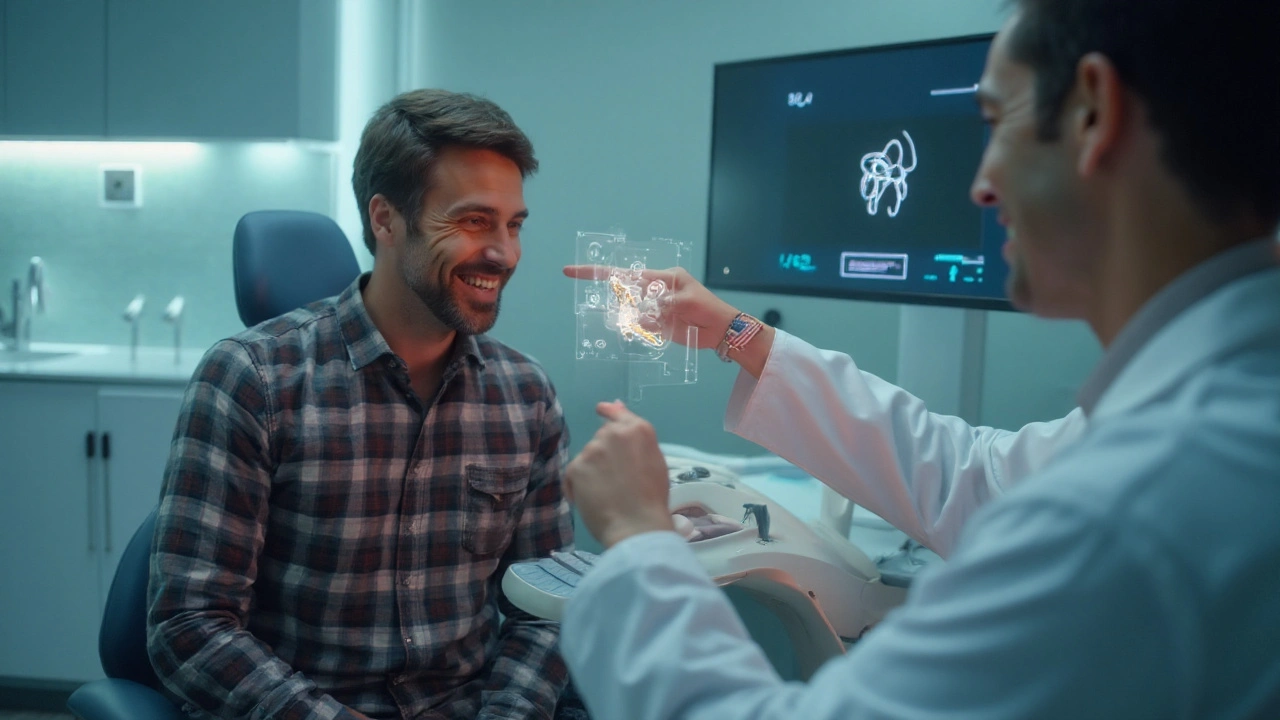Osteodystrophy and Dental Health: Essential Facts You Should Know
 Aug, 9 2025
Aug, 9 2025
Osteodystrophy is a disorder of bone metabolism that alters the structure and strength of the skeleton, typically driven by disturbances in calcium homeostasis, hormonal imbalances, or chronic kidney disease. When the bones supporting the teeth become compromised, oral health can deteriorate rapidly, leading to pain, infection, and even tooth loss.
Key Takeaways
- Bone‑related disorders directly influence the health of teeth and jawbone.
- Calcium, vitamin D, and parathyroid hormone levels are central to both bone and dental integrity.
- Renal osteodystrophy and hyperparathyroidism present distinct dental challenges.
- Early dental assessment and coordinated medical care can prevent irreversible damage.
- Proper oral hygiene, nutrition, and medication management are the cornerstones of care.
Understanding Osteodystrophy
To grasp why teeth are affected, you first need a quick look at the underlying physiology. Bone metabolism is the continuous process of bone formation by osteoblasts and resorption by osteoclasts. In a healthy system, calcium and phosphate are tightly regulated, allowing the skeleton to remodel without losing strength.
Two main hormonal players drive this balance:
- Parathyroid hormone (PTH) raises blood calcium by stimulating osteoclast activity and renal reabsorption.
- Vitamin D enhances intestinal calcium absorption and supports osteoblast function.
If either hormone is out of whack, bone tissue becomes either too dense or too porous-both scenarios describe forms of osteodystrophy. Chronic kidney disease (CKD) is a frequent culprit because the kidneys fail to activate vitaminD and excrete phosphate, leading to what clinicians call Renal osteodystrophy.
How Bone Health Impacts Teeth
The teeth sit in sockets called alveolar bone. When osteodystrophy weakens this bone, the socket can shrink, tilt, or lose density, making teeth feel loose and increasing the risk of periodontal disease.
Key oral structures linked to bone metabolism include:
- Alveolar bone - the part of the jaw that holds each tooth in place.
- Tooth enamel - the outer hard layer whose formation relies on adequate calcium during childhood.
- Periodontal ligament - connective tissue that can become inflamed when bone support weakens, leading to periodontal disease
When calcium homeostasis falters, enamel can become more prone to demineralization, and the immune response in the gums may weaken, both paving the way for cavities and gum recession.
Common Dental Problems Linked to Osteodystrophy
Patients with bone‑metabolism disorders often report a pattern of oral issues:
- Increased tooth mobility due to alveolar bone loss.
- Higher prevalence of periodontal pockets and bleeding gums.
- Delayed healing after extractions or periodontal surgery.
- Higher risk of osteonecrosis of the jaw (ONJ) when on bisphosphonate therapy, a medication that suppresses bone turnover.
- Frequent root caries because weakened enamel offers less protection.
These problems often appear together, so a multidisciplinary approach-dentist, endocrinologist, nephrologist-is essential.

Diagnosis and Imaging
Detecting dental complications early relies on both clinical exams and radiographic tools. The dentist will assess pocket depth, mobility, and signs of infection, while the physician may order labs for calcium, phosphate, PTH, and 25‑OH vitaminD levels.
Radiographs provide a visual map of bone health. Typical findings include:
- Reduced trabecular density in the mandibular cortex.
- Widened periodontal ligament space.
- Periapical radiolucencies indicating chronic infection.
Advanced imaging such as cone‑beam CT can reveal three‑dimensional changes in the alveolar ridge, useful when planning implants or major extractions.
Managing Oral Health When You Have Osteodystrophy
Effective management blends systemic treatment with meticulous oral care.
Optimize Bone‑Related Labs
- Maintain serum calcium in the 8.5‑10.2mg/dL range.
- Target 25‑OH vitaminD levels above 30ng/mL.
- Control PTH according to disease‑specific guidelines (e.g., < 150pg/mL for secondary hyperparathyroidism).
Medication Considerations
Bisphosphonates such as alendronate or intravenous zoledronic acid are common for slowing bone loss, but they raise the risk of ONJ. If you need a dental extraction, your physician may pause the drug for 2‑3months and the dentist will employ atraumatic techniques.
Daily Oral Hygiene
- Brush twice daily with a fluoride toothpaste (≥ 1000ppm).
- Floss or use interdental brushes to disrupt plaque at the gum‑bone interface.
- Consider a chlorhexidine mouth rinse for two weeks after any invasive procedure.
Nutrition and Lifestyle
Calcium‑rich foods (dairy, fortified plant milks, leafy greens) and vitaminD sources (fatty fish, sunlight exposure) support both bone and enamel. Smoking and excessive alcohol accelerate bone loss and should be avoided.
Regular Dental Visits
Schedule cleanings every six months, or more often if you have active periodontal disease. Ask your dentist to perform a periodontal chart and radiographic review at each visit.
Comparison of Dental Impact: Renal Osteodystrophy vs Primary Hyperparathyroidism
| Condition | Typical Dental Issues | Radiographic Signs | Management Approach |
|---|---|---|---|
| Renal osteodystrophy | Severe alveolar bone loss, delayed healing, higher ONJ risk with bisphosphonates | Subperiosteal bone resorption, loss of mandibular cortex density | Control phosphate, active vitaminD analogs, coordinated dental‑medical timing for procedures |
| Primary hyperparathyroidism | Tooth mobility, brown tumors in jaw, increased caries due to enamel demineralization | Well‑defined radiolucent lesions (brown tumors), generalized osteopenia | Surgical parathyroidectomy or calcimimetics, calcium/vitaminD supplementation, regular periodontal monitoring |
Related Concepts and Next Steps
Understanding the link between bone disease and oral health opens doors to broader topics. Within the larger health cluster, you might explore:
- Systemic effects of periodontal disease - how gum inflammation can worsen cardiovascular risk.
- Bone‑density testing for dental patients - when a DEXA scan is indicated before implants.
- Nutrition for bone‑healthy teeth - specific micronutrients beyond calcium and vitaminD.
Each of these threads deepens the conversation about keeping your smile strong while navigating chronic bone conditions.

Frequently Asked Questions
Can osteodystrophy cause tooth loss?
Yes. When the alveolar bone resorbs faster than it can remodel, the support for each tooth weakens, leading to mobility and eventually loss if left untreated.
Should I stop bisphosphonate medication before dental work?
Most clinicians recommend a drug holiday of 2‑3months before invasive procedures, but the exact plan must be decided jointly by your dentist and prescribing physician.
What lab values indicate that my bone metabolism is under control?
Aim for serum calcium 8.5‑10.2mg/dL, phosphate within the normal range for your age, PTH below disease‑specific thresholds (often <150pg/mL for secondary hyperparathyroidism), and 25‑OH vitaminD above 30ng/mL.
How often should I see my dentist if I have renal osteodystrophy?
At least every six months, with additional visits if you notice bleeding gums, loose teeth, or after any surgical procedure.
Can improving oral hygiene reverse bone loss in the jaw?
Good oral hygiene can halt further periodontal destruction, but it won’t rebuild lost alveolar bone. Reversal usually requires medical management of the underlying osteodystrophy and, in some cases, bone‑regenerative procedures.
Wendy Chiridza
September 23, 2025 AT 18:02Finally, someone explains this without jargon overload. I’ve had renal osteodystrophy for 8 years and my dentist never connected my loose teeth to my kidneys until I brought this up. The part about alveolar bone loss making flossing feel like a battle? Spot on.
My PTH’s been hovering at 180 for months. I’m trying the vitamin D3 + K2 combo now-no magic fix, but my gums aren’t bleeding as much after brushing.
Erik van Hees
September 25, 2025 AT 12:20Y’all are missing the big picture. This isn’t just about calcium and PTH-it’s about the pharmaceutical-industrial complex pushing bisphosphonates like candy. My uncle got ONJ after a routine extraction and now he can’t eat solid food. The real villain? Drug companies selling bone drugs to people who don’t need them.
And yes, I’ve seen the studies. Most are funded by pharma. Don’t trust the ‘guidelines’-ask your nephrologist if they get kickbacks.
Mark Gallagher
September 26, 2025 AT 16:17Wow. This post is basically a textbook chapter. But let me just say-why are we even talking about this like it’s new? Every dentist in America who’s worked with CKD patients since the 90s knew this. You think you’re breaking news? You’re just catching up.
Also, ‘fluoride toothpaste ≥1000ppm’? That’s the bare minimum. Use 1450. And stop calling it ‘toothpaste’-it’s fluoride gel with a minty coat. Get real.
Pamela Mae Ibabao
September 26, 2025 AT 16:57Okay but can we talk about how weird it is that we treat bone and teeth like separate systems? Like, your jaw isn’t just ‘supporting’ your teeth-it’s part of them. The enamel forms from the same mineral pool as your femur.
I used to think cavities were just sugar’s fault. Then I got my labs back and saw my calcium was 7.9. Three months of vitamin D and my dentist asked if I’d been secretly getting implants. Nope. Just stopped eating cereal for breakfast.
Joanne Rencher
September 27, 2025 AT 14:46So… you’re telling me I need to stop drinking soda and start taking supplements because my teeth are falling out? Newsflash: I’m 24 and I’ve never had a bone scan. This feels like fearmongering dressed up as science.
Palanivelu Sivanathan
September 29, 2025 AT 05:33Bro… this is the universe whispering to us through our gums. The jawbone? It’s the mirror of the soul’s internal balance. When the kidneys fail, the body screams through the teeth-because teeth are the last thing to hold on when the spirit is crumbling.
I’ve seen people with brown tumors in their jaws… and they were all spiritually disconnected. Meditation helps. Also, avoid dairy. It’s mucus. Mucus blocks chi. Chi flows through bone.
Also, why is no one talking about the moon’s gravitational pull on calcium? It’s all connected. I’m writing a book. Send help.
Cristy Magdalena
September 29, 2025 AT 10:21I just got diagnosed with secondary hyperparathyroidism last week. My dentist said I have ‘advanced alveolar resorption’ and I cried for three hours. I thought I was just bad at brushing.
Now I’m terrified to smile. I keep touching my teeth to see if they’re still there. I’m scared to eat anything crunchy. I don’t even want to look in the mirror anymore. Is this… is this going to get worse? I just want to feel normal again.
Gerald Nauschnegg
October 1, 2025 AT 06:15Okay but I’ve been on bisphosphonates for osteoporosis since 2020 and my teeth are fine. I brush twice, floss, use Listerine, and drink milk like it’s my job. So maybe it’s not the drug-it’s the combo of bad habits and bad genetics?
Also, I’m a dentist. I’ve seen 3 cases of ONJ in 12 years. It’s rare. Stop acting like it’s the plague. Your teeth aren’t falling out because of Big Pharma. They’re falling out because you skipped cleanings for 5 years.